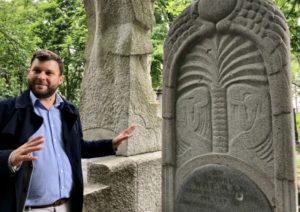By Eliana Rudee
Michal Laszczkowski, CEO of Poland’s Cultural Heritage Foundation, spends a great deal of time discussing Jewish law with rabbis at various Jewish cemeteries across Poland. Yet Laszczkowski is not Jewish.
As the man behind the $28 million restoration and documenting of Jewish sepulchral heritage in Poland, Laszczkowski has helped the organization raise funds from Poland’s Ministry of Culture and National Heritage, and the Capital Monument Conservation Office. In addition to their biggest project — cleaning up the major Jewish cemetery in Warsaw — the foundation’s other work includes the preservation of other Jewish and Muslim cemeteries, churches, and various national heritage sites connected to Polish heritage abroad.
The Jewish cemetery in Warsaw on Okopowa Street was built in 1806 outside the city ramparts, and is one of the last Jewish cemeteries in Poland that is still being used. From its founding until 1939, some 150,000 Jews were buried there, representing 10 to 15% of Jewish tombstones in Poland.
So far, under the direction of rabbis who ensure that the restoration work is done according to Jewish law, the organization has renovated more than 100 tombstones and gravestone art, and they have also cut down bushes, weeds and about 500 wild trees that pose a danger to those who visit the cemetery. According to Laszczkowski making the area safer and better preserved will bring more people to the cemetery, Jews and non-Jews alike.
Because the cemetery and the heritage of the Jewish community was almost totally destroyed during WW II, with Nazis stealing Jewish tombstones for building projects and street pavements, Laszczkowski expressed the need for Poles “to have a place to understand Jewish heritage and contributions to Polish society.”
The cemetery does just that, with styles of the tombstones and the contents of the epitaphs reflecting the diversity of Warsaw’s Jewish community.
Although the cemetery archives were burned during the war, and thus the identity of many buried there are unknown, information from the monuments shows that among those buried at the cemetery are thousands of victims of the Warsaw ghetto, buried in mass graves; rabbis and tzadikim (“righteous Jews”); leaders of secular movements like the assimilation movement, Zionism, and socialism; promoters of Hebrew; and Yiddish writers, journalists, and actors.
Highlighting the prominence of the Jewish presence in pre-war Warsaw, people buried there also include those who were at the forefront of Polish life: leaders of Polish uprisings, industrialists, physicians, scientists, artists, publishers, philanthropists, and patrons of culture.
Still, Laszczkowski views the cemetery as a missed opportunity. While 40,000 tourists visit the cemetery each year, he estimates that only 10% of them are non-Jews.
With only 400 Jews living in Warsaw (less than 1% of the Jewish community of nearly 375,000 in 1939) most Poles do not know Jews or about Jewish tradition, he said.
“They should know that Jews were in the public of Polish society,” he stated.
Laszczkowski’s vision is to increase the number of non-Jews who visit by making it a mandatory part of Polish education. “I want to organize a large program where every Warsaw student comes to this cemetery during high school,” he said.
“Poles are afraid to come inside the cemetery, and so they don’t open the door . . . I want to make this an exotic, attractive place.”
In late 2017, after touring the cemetery with Laszczkowski, Polish Deputy Prime Minister and Minister of Culture and National Heritage Piotr Glinski allocated 100 million zloty (more than $26 million) to the foundation.
The donation represented some 2% of the ministry’s 2018 budget, and nearly half of the budget earmarked for “institutions whose activities include taking care of the memory, culture and heritage of the Jewish nation,” which also includes the Auschwitz-Birkenau State Museum, the Jewish Historical Institute, the State Museum at Majdanek, and the Museum of History of Polish Jews — POLIN.
“The heritage of Jews is the heritage of Poland,” said Glinski in a meeting with Israeli journalists earlier this month.
“Knowledge of Polish history, including Jewish history and during the Second World War, is insufficient everywhere,” he said.

















